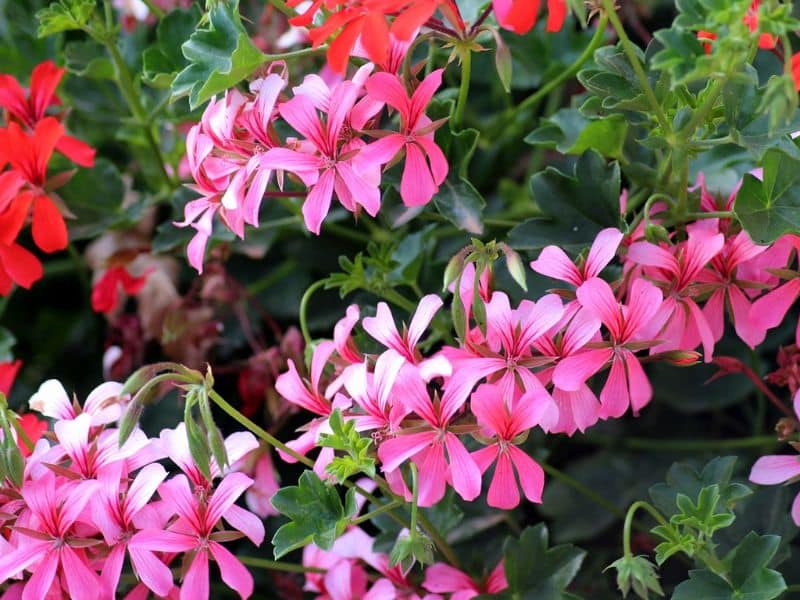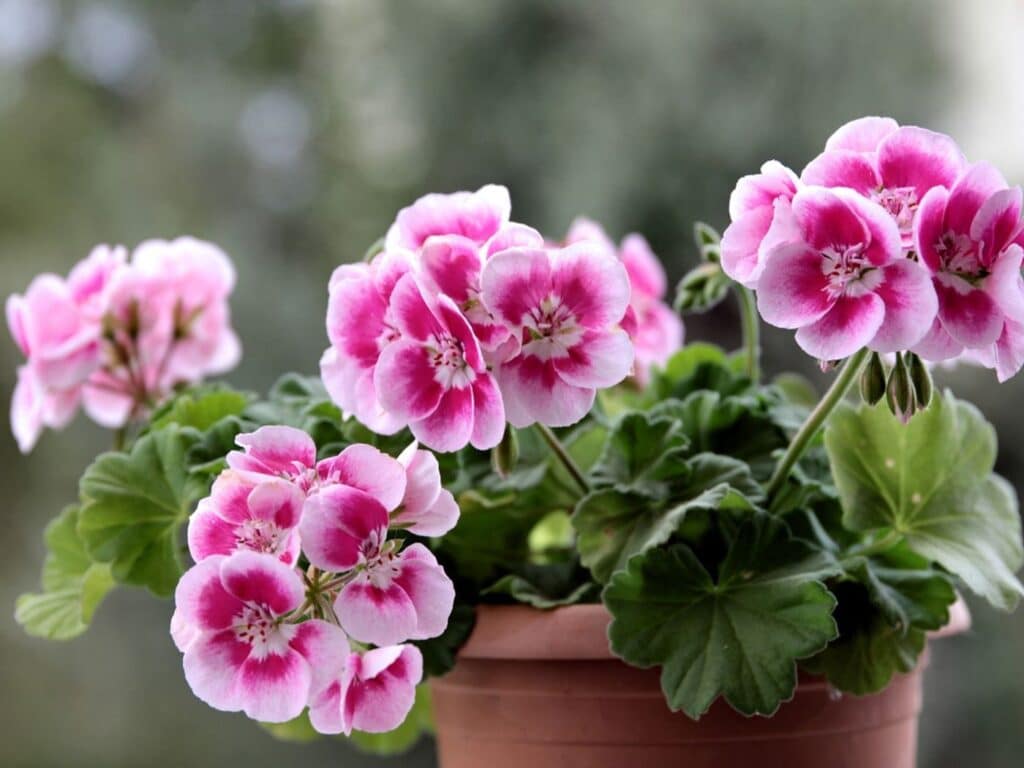Have you ever watched in dismay as your vibrant geraniums turned yellow and wilted, despite your best efforts to keep them hydrated? You’re not alone. Overwatering is a common mistake that can lead to the downfall of these otherwise resilient plants.
In this article, we’ll explore the signs of overwatered geraniums, delve into the reasons why it’s such a prevalent issue, and most importantly, share tips on how to nurse your plants back to health. It’s time to reclaim your green thumb and help your geraniums thrive once more.
Signs of Overwatered Geraniums
The signs of overwatered geraniums are clear if you know what to look for. Let’s delve into the primary symptoms to help identify this issue.
Wilting and Yellowing Leaves
One of the first signs you’re overwatering your geraniums is wilting and yellowing leaves. While it’s common for geraniums to lose their lower, older leaves naturally, if the discoloration is affecting the entire plant, you may well be overwatering.
The leaves may appear yellow and start wilting, even though the soil is wet. It’s like they’re drowning and crying out for change!
Root Rot and Its Identification
Root rot can be a silent killer in overwatered plants. With geraniums, they may appear healthy above the soil, but if you see them wilting despite a wet soil, it’s time to check the roots. Healthy roots look white or cream-colored and feel firm.
Rotting roots, conversely, are brown or black, with a mushy or slimy texture. In a severe case of root rot, a foul smell emanates from the plant. You’ll need to take swift action to save your plant if you spot these signs.
Mold and Algae on Soil Surface
If you’re overwatering your geraniums, chances are high that mold and algae will appear on the soil surface. The excess water creates a damp environment that’s perfect for these unsightly organisms to flourish.
Take note of any changes to the color or texture of your soil, as these may point to a mold or algae invasion facilitated by overwatering.
Causes of Overwatering Geranium Plants

After exploring how overwatering affects geraniums, it’s time to discover what could be causing this common issue. Understanding the causes can help you avoid overwatering in the future.
Incorrect Watering Practices
Often, geraniums are overwatered due to improper watering routines. Some people believe more water equates to a healthier plant. In reality, geraniums prefer their soil to partially dry out between watering sessions. They’re prone to root damage when the soil remains overly wet for extended periods.
Watering too frequently or heavily may make your geraniums susceptible to diseases and root rot. So, it’s essential to preserve a balanced watering schedule based on your plant’s needs and the environment it is growing in.
Unsuitable Pot and Soil Type
The type of pot and soil you’re using can also contribute to overwatering issues. Geraniums need well-drained soil to prevent water accumulation around the roots. Soils rich in clay often retain more water, making your plant prone to overwatering. Using inappropriate soil can be a straight road to root rot.
Similarly, pots without adequate drainage holes can cause water to pool at the bottom, leading to saturation and overhydration. Always ensure you’re using a pot with sufficient drainage and potting mix formulated for geraniums or other similar plants to maintain optimal moisture levels.
Preventive Measures for Overwatering
Taking preemptive action can save you the heartache of losing your beloved geraniums to overwatering. Here, we’re going to talk about how to select the proper soil and pot and how to adjust watering to the environmental requirements of your geraniums to prevent overwatering.
Choosing the Right Soil and Pot
A good start to preventing overwatering of your geraniums is choosing the right soil and pot. Always go for a light, well-drained soil type for geraniums. This soil allows excess water to drain out, mitigating the risk of overwatering and root rot.
When it comes to choosing a pot, opt for ones with sufficient drainage holes. The holes enable excess water to escape, keeping the roots from sitting in standing water. A ceramic or terracotta pot is often a good choice as they lose moisture through evaporation, helping to prevent overwatering.
Monitoring Water Needs Based on Environment
The environmental factors your geraniums are exposed to drastically impact their water requirements. The amount of light, temperature, and humidity they experience will influence how often you need to water them.
Geraniums situated in high-light conditions will need more frequent watering than those in lower light conditions.
Similarly, if the temperature is high or if your space has low humidity, your geraniums will require more water. Always check the moisture level of the soil before watering to avoid overwatering. A soil moisture meter can be a handy tool for this.
Remember, preventing overwatering of geraniums isn’t tricky; it just requires attention to your plant’s needs and a balance between those needs and your watering practices.
Steps to Salvage Overwatered Geraniums
If you’ve unwittingly drenched your geraniums, don’t fret – it’s possible to salvage them with swift action and proper care. Here are proactive steps you can take to help your overwatered geraniums recover.
Reducing Water Intake Immediately
The first thing you’ll want to do is halt watering. Overwatered geraniums need a chance to recover and dry out, so resist the urge to water them right away.
Monitor your plant closely and only aim to water again when the top inch of the soil has dried out completely. In this way, you’ll avoid adding to the water stress and give the plant time to recover.
Repotting into Fresh, Dry Soil
Sometimes, the best course of action is to give your geraniums a fresh start. Carefully remove the plant from the waterlogged pot and gently shake off the wet soil from the roots.
After the plant has been extracted, repot it using fresh, dry soil conducive to good drainage. Remember to select a pot with enough drainage holes to prevent water pooling in the future. This will provide a new, healthy environment for your geranium to grow.
Pruning Affected Leaves and Roots
Finally, grooming your plant can also contribute to its recovery. Pruning away the affected leaves and roots encourages healthier growth and stops the spread of damaging factors like root rot.
Use a sterile tool to prune off yellowed or wilted leaves, and remove any mushy, black roots. Always be gentle during this process to minimize potential harm to the plant. With these steps, you’re on your way to nursing your overwatered geranium back to health.
Long-Term Care for Geraniums After Overwatering
Overwatering can damage your geraniums, but don’t worry! With proper ongoing care, you can help these resilient plants recover and thrive. This section provides valuable tips on long-term care for your geraniums post-recovery.
Regular Checks for Signs of Stress or Disease
Your geraniums have had a rough time, but they’re on the mend. You’ve taken the initial steps to ensure recovery, but ongoing success involves regular check-ins. Inspect your plants often for signs of undue stress, such as discolored leaves, wilted stems, and stunted growth.
If you spot any signs of recurring disease like root rot or mold, take action immediately. Utilize a plant-safe fungicide or consider repotting the affected plants into fresh soil. Being proactive will thwart the onset of further complications.
Adjusting Watering Schedules
Maintenance of a balanced watering routine plays a crucial role in your geraniums’ health post-recovery. Track environmental conditions like temperature and humidity while establishing a watering schedule. Remember, your geraniums prefer to dry out between watering events; Overwatering leads to trouble.
Aim to keep the soil slightly dry, but not parched. A handy trick is to insert a finger into the soil; if the top inch is dry, it’s watering time. This tailored strategy helps maintain optimal soil hydration, promoting plant health in the long run.
Up next:







